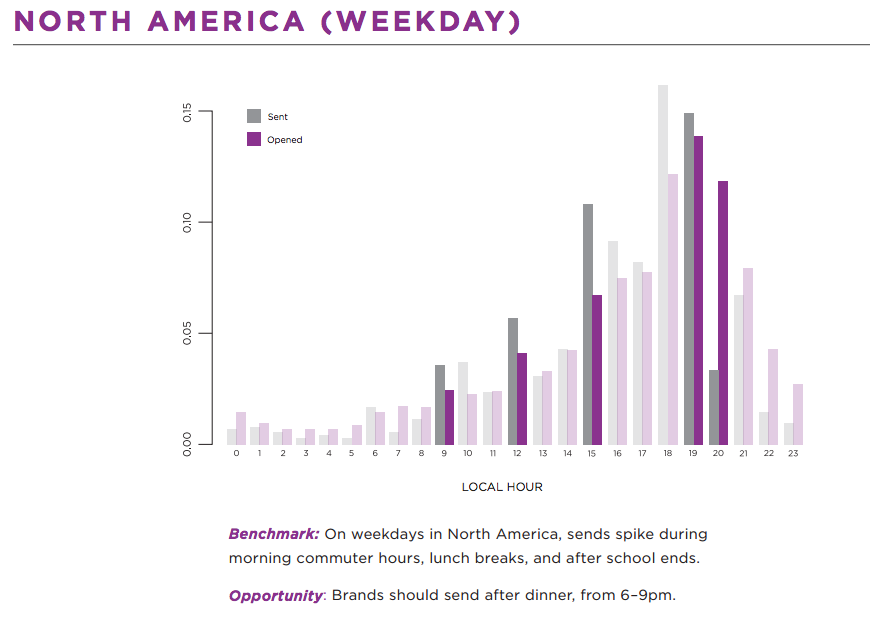Leanplum, a mobile marketing automation platform, is announcing its first research study today, called “Breaking Barriers to Push Notification Engagement.” The study, which is the result of an analysis of 671 million push notifications and 1.4 billion in-app events, reveals that upwards of 63 percent of marketers around the world completely miss the mark on messaging, timing, and the frequency of their app marketing efforts.
Here is how some of the key findings of the study break down:
- App marketers in North America, especially, are missing opportunities to engage with users in evening hours. For example, app users open push notifications at 8 p.m. four times as often as they’re being sent.
- This draws on another key finding in the study: sends versus opens. All around the world, the times that marketers send push notifications and the times users are actually opening and engaging with them are out of sync, often resulting in out-of-date messaging.
- Marketers often totally miss with time zones — e.g., in EMEA, marketers are sending pushes at midnight, when most users are sleeping — as they focus on hitting peak times in North America instead of creating local campaigns.

I caught up with Leanplum CEO Momchil Kyurkchiev to get a sense of why mobile marketers are struggling with what feels like basic marketing anatomy. I especially wanted to know why, after nearly 700 million push notifications, marketers are still sending messages at the wrong time.
“It’s simple,” Kyurkchiev said. “There’s a personalization gap. We are still seeing a fair amount of generic blasts, which are based on the old ways marketers utilized email and other web-centric tactics. Mobile needs to be personal. When marketers don’t use personalization solutions that take into account location, timing, and behavior-based triggers, they’re missing out on mobile’s relevancy opportunity.”
Leanplum tackles this “personalization gap” in a number of ways through its core platform. The messaging product was among the most robust vendors featured in our report on mobile marketing automation solutions, with tools like programmatic delivery and optimal time messaging (uses machine learning to match customer behaviors to optimal messaging), ‘soft’ push notifications, email, and other features.
This year’s VentureBeat Mobile Summit will feature several working sessions around mobile growth, including how best to harness data for mobile engagement. It takes place April 4-5 at the scenic Cavallo Point Resort in Sausalito, CA.
Space is extremely limited — we’ve only got seats for a total of 180 executives — but it’s not too late to apply for one of the remaining seats.
I also caught up with Mike Abbott, general partner at Kleiner Perkins Caulfield & Byers, who led Leanplum’s $11.6 million round last summer. I wanted to know what makes Leanplum stand out in a rapidly expanding marketplace, and what investors, entrepreneurs, and marketers have to be excited about in 2016 for mobile.
Abbott said, “What we’re seeing is marketing’s autonomy from IT. When I’ve spent time with Fortune 500 companies, in many cases, the mobile team was off to the side instead of integrated. I tend to believe, like many applications in the enterprise, companies that approach these types of problems from day zero or natively are ultimately going to win. I wouldn’t be surprised if other functional applications outside of marketing automation follow suit.”
Abbot continued, “Tools like Leanplum help different marketing groups find those conclusions today, and faster than ever. At some point, the word “mobile” is going to go away.”
For now, “mobile” is a well-entrenched term, channel, strategy, and investment vehicle — and “fast” doesn’t even begin to describe the activity in this space. In that sense, missing the mark on something as simple as appropriate messaging may not be entirely the marketer’s fault. Mobile’s marketing landscape is as dynamic and fast-moving as any major marketplace to date. Just a few months back, at VB Insight, we released the mobile success landscape in a partnership with VB Profiles. You can track the companies yourself or get the free e-book with all the details.

A fast-moving marketplace has meant rapid iteration within the actual platforms and tactics themselves, which has challenged user acquisition, in particular. The app install advertising ecosystem is in constant flux, with new app formats from Google and new players offering different ad inventory from previous years. This means that merely testing the latest options for viability is a hugely resource-intensive process, and that’s not even looking at what it takes to get your messaging right.
The next step is understanding who your customers are by segmenting them based on in-app behaviors. These include their interests, activities, and even the times of day they’re most likely to interact with your business. To answer what ‘best in class’ means for each of these questions, we’re tracking mobile user acquisition, mobile monetization, mobile app analytics, mobile marketing automation, and much more.
VentureBeat's mission is to be a digital town square for technical decision-makers to gain knowledge about transformative enterprise technology and transact. Learn More

